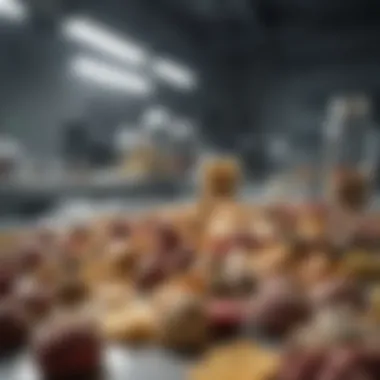Understanding Freeze-Drying: Definition and Applications


Intro
Freeze-drying is a process that significantly influences the preservation of various substances without compromising their quality. This method, known scientifically as lyophilization, involves removing moisture from a product at low temperatures. As the demand grows in multiple sectors, understanding this technique's nuances becomes essential for professionals navigating food science, pharmaceuticals, or bioresearch.
The importance of freeze-drying lies in its ability to maintain the original structure and nutritional content of the material involved. This ensures that food products remain palatable and that pharmaceuticals retain their effectiveness over time. With the progress of technology, freeze-drying has evolved, making it more efficient and versatile in its applications.
This article aims to dissect each aspect of freeze-drying, from its technical underpinnings and historical context to its broad applications in various fields. By exploring these elements, readers will gain profoundly useful insights, especially those engaged in scientific research or practical applications.
Research Highlights
Key Findings
- Preservation of Nutrients: Freeze-drying preserves vitamins, minerals, and more effectively than traditional methods.
- Applications Across Fields: Industries from food to pharmaceuticals utilize freeze-drying differently, benefiting from its unique attributes.
- Technological Advancements: Recent innovations have enhanced the efficiency and safety of the freeze-drying process.
These highlights reflect the critical role freeze-drying plays across various domains, emphasizing its relevance in modern science and industry.
Implications and Applications
The implications of freeze-drying extend far beyond mere preservation. In the food industry, it allows for lightweight and shelf-stable products. Freeze-dried fruits, such as strawberries and apples, retain their taste and nutrition while providing convenience.
In the pharmaceutical sector, the capacity to stabilize vaccines and antibiotics enhances their shelf life and usability in diverse environments. Similarly, in bioresearch, lyophilization serves as a pivotal means to store biological samples without degradation.
"Freeze-drying has become an indispensable method in biological and food sciences, showcasing remarkable efficiency in material preservation."
Methodology Overview
Research Design
The exploration of freeze-drying requires a blend of experimental techniques and theoretical frameworks. Typically, researchers carry out comparative studies using different products to analyze the effectiveness and efficiency of freeze-drying versus other preservation methods.
Experimental Procedures
The procedures involved vary based on the material being freeze-dried. Generally, the process includes the following steps:
- Freezing: The substance is cooled below its freezing point.
- Primary Drying: Sublimation occurs, where ice transforms directly into vapor.
- Secondary Drying: Remaining moisture is removed to achieve the desired dryness.
Adhering to these careful steps ensures optimal preservation results, enabling the significant utility of freeze-drying across multiple sectors.
Prolusion to Freeze-Drying
Freeze-drying is a process that warrants understanding due to its diverse applications. The technique not only extends the shelf life of products but also retains their essential qualities. In this section, we will outline the definition and relevance of freeze-drying in various fields, emphasizing its significance in food preservation, pharmaceuticals, and biotechnological research.
Definition of Freeze-Drying
Freeze-drying, also known as lyophilization, can be defined as the process of removing moisture from a product after it has been frozen. The method involves several stages: freezing, primary drying, and secondary drying. Initially, the product is frozen to solidify its moisture content. Following this, a vacuum is applied which causes the ice to sublimate, transitioning directly from solid to vapor without passing through a liquid state. This results in a dried product that maintains its structural integrity and biochemical properties.
It is important to note that this process is used widely, appearing in various industries that require high-quality preservation solutions. The outcome is a lightweight product that can be easily stored and transported.
Importance of Freeze-Drying
The importance of freeze-drying extends far beyond simple dehydration. Here are several key points elucidating its role:


- Nutritional Retention: One of the most notable benefits of freeze-drying is the retention of nutrients. Unlike other methods, such as canning, where heat can destroy vitamins and minerals, freeze-drying preserves nutritional content effectively.
- Extended Shelf Life: Freeze-dried products can last years without refrigeration, making them ideal for long-term storage. This feature is particularly valuable in the food industry and pharmaceuticals, where quality and efficacy must be maintained over time.
- Enhanced Convenience: For consumers, freeze-dried foods offer convenience. They are lightweight and easy to prepare, appealing to outdoor enthusiasts and emergency preparedness scenarios.
- Technological Innovation: In the pharmaceutical industry, freeze-drying plays a crucial role in stabilizing biological products, such as vaccines and other medications. It allows for the preservation of active ingredients that need to remain viable over time.
Freeze-drying transforms the landscape of product preservation, facilitating innovations across sectors.
In summary, a thorough understanding of freeze-drying is essential for comprehending its current and future applications. This topic is particularly relevant as it intersects with interests in food science, medicine, and biotechnological advancements.
The Process of Freeze-Drying
Understanding the process of freeze-drying is critical, as it showcases how this preservation method effectively retains both quality and nutritional value. Different phases come into play during freeze-drying, each significantly contributing to the final product. Moreover, the choice of equipment plays a vital role in ensuring efficiency and consistency in the process. In this section, we will explore the phases of freeze-drying and the equipment utilized.
Phases of Freeze-Drying
Each phase in the freeze-drying process brings unique qualities that are essential for achieving the desired results. The sequence includes freezing, sublimation, and storage phases, which work together to successfully remove moisture without compromising the integrity of the material.
Freezing Phase
The freezing phase initiates the freeze-drying process. Here, the material is cooled to a temperature below its freezing point, typically around -50 to -80 degrees Celsius. This phase is fundamental as it transforms the liquid content into ice. One of the key characteristics of this phase is its ability to preserve cellular structures, which is vital for maintaining texture and flavor after drying. The freezing phase proves advantageous, allowing the sublimation process to happen more effectively. However, if the freezing rate is too slow, it can cause the formation of large ice crystals, which may damage the product's structure.
Sublimation Phase
Following freezing, the sublimation phase takes center stage. Here, vacuum pressure is applied, causing the ice to turn directly into vapor without passing through a liquid state. This phase is crucial because it minimizes any temperature fluctuations that could harm the quality of the material. The key feature of sublimation is its efficiency in moisture removal while maintaining the original properties of the product. Advantages include better retention of flavor and nutritional content compared to traditional drying methods. The downside, however, is the complexity of maintaining the optimal pressure and temperature to ensure a successful sublimation.
Storage Phase
The storage phase is where the dried product is safeguarded until it reaches the end-user. Proper storage conditions are essential to prevent moisture reabsorption, which would compromise the quality of the freeze-dried material. The unique feature of this phase is the controlled environment in which the product is kept, often in vacuum-sealed containers that keep out moisture and air. This phase is beneficial as it extends shelf life considerably, but it requires careful monitoring to maintain optimal conditions and prevent spoilage.
Equipment for Freeze-Drying
The choice of equipment greatly influences the efficiency and effectiveness of the freeze-drying process. Among the essential tools are lyophilizers and vacuum systems, both of which play specific roles in achieving high-quality results.
Lyophilizers
Lyophilizers are integral to the freeze-drying process. These specialized machines effectively facilitate the freezing and sublimation phases. A standout characteristic of lyophilizers is their capability to control temperature and pressure precisely during the freeze-drying process. This precision is particularly advantageous, as it allows for consistent results across various batches. However, the cost of lyophilizers can be a concern for smaller operations, requiring considerable investment.
Vacuum Systems
Vacuum systems are equally essential in freeze-drying, as they create the low-pressure environment necessary for the sublimation phase. The primary advantage of using vacuum systems is their role in speeding up moisture removal, thus enhancing the efficiency of the process. The unique feature of these systems is their ability to work alongside lyophilizers seamlessly. Despite their benefits, vacuum systems can be seen as a costly addition to the equipment needed for freeze-drying, which may deter some users.
Proper understanding of each phase and the corresponding equipment is crucial for anyone involved in the freeze-drying industry.
Applications of Freeze-Drying
Freeze-drying is widely employed across several sectors. This process is essential in maintaining the quality and prolonging the shelf life of various products. Understanding its applications enables us to grasp the significance of freeze-drying technology in modern industries, especially in food preservation, pharmaceuticals, and biotechnology.
Use in Food Preservation
Benefits for Food Products
One of the main advantages of freeze-drying food is the extended shelf life. This method removes the moisture from food items without compromising their integrity. Foods retain much of their original flavor, color, and nutritional content, which is vital for consumers seeking quality products. For instance, freeze-dried fruits maintain their vitamins and minerals, making them a healthier snack option compared to traditional preservation methods like canning.
Additionally, freeze-dried products are lightweight and portable. This characteristic is appealing for outdoor activities and emergency supplies. Consumers value food that is convenient to store and transport, leading to increased market demand.
Market Trends in Freeze-Dried Foods


Recent years have seen growing interest in freeze-dried foods. Consumers are becoming more health-conscious, favoring options that retain maximum nutrients. The rise in outdoor activities like camping has also spurred demand for these products. Brands that offer freeze-dried ingredients, like Mountain House and Backpacker's Pantry, are gaining popularity among food enthusiasts.
However, the market is not without challenges. Freeze-drying can be costlier than other preservation methods, which may deter some consumers. Despite this, the growing trend towards natural and healthy eating continues to push the demand for freeze-dried products.
Pharmaceutical Applications
Stability of Biological Products
In pharmaceuticals, freeze-drying is crucial for preserving biological products such as vaccines and proteins. This method prevents degradation, allowing for better storage solutions. Biological materials are sensitive and can lose their efficacy if not handled correctly. Freeze-drying provides a stable state, ensuring that products remain effective for longer periods.
Moreover, the dry state enhances the mobility of these products, making them easier to pack and distribute. This is particularly important for vaccines, where maintaining stability until administration can be a matter of public health.
Impact on Drug Delivery Systems
The impact of freeze-drying on drug delivery is profound. In many cases, it enables the formulation of drugs in a stable powder form. This feature is beneficial for pharmaceuticals, as it allows for precise dosing and extended shelf life. The technology aids in the development of sustained-release formulations, providing patients with consistent drug levels in their systems.
However, the complexity of formulating these drugs must be managed. The freeze-drying process requires meticulous attention to detail, as any miscalculation can affect the drug's effectiveness. Thus, while it offers significant benefits, careful consideration must be given during production.
Biotechnology and Research
Sample Preservation Techniques
In research settings, freeze-drying is utilized frequently to preserve biological samples. This method protects samples from deterioration, especially those vulnerable to heat and moisture. Researchers often face hurdles with sample storage, and freeze-drying presents an effective solution to maintain sample viability over time.
An important characteristic is that freeze-dried samples can be easily transported. Researchers can send samples over long distances without fear of degradation. This capability is crucial for collaborative studies across different institutions.
Use in Vaccine Development
Vaccine development has greatly benefited from freeze-drying technology. It ensures the stability of vaccine components, crucial for effective immunization programs. Freeze-drying allows for simplified storage and distribution, particularly in remote areas where refrigeration facilities may not be reliable.
The unique feature of this application lies in its ability to maintain potency. By providing a dry and stable formulation, the risks associated with storage and transport are minimized. Nonetheless, it requires specialized equipment and ongoing research to optimize these formulations. Understanding this balance is essential for the advancement of public health initiatives.
Advantages and Disadvantages of Freeze-Drying
Understanding the advantages and disadvantages of freeze-drying is crucial for evaluating its applications and overall impact in various fields. Each aspect presents unique insights that are essential for making informed decisions about this preservation method. In the following sections, we will explore the advantages and disadvantages of freeze-drying, emphasizing its role in food preservation, pharmaceuticals, and biotechnological applications.
Advantages of Freeze-Drying
Extended Shelf Life
One of the main advantages of freeze-drying is its ability to provide an extended shelf life for perishable products. This process removes moisture effectively, which is a key factor in the degradation of food and biological materials. By eliminating water, the conditions for spoilage and microbial growth are significantly reduced.
The key characteristic of extended shelf life is that it allows products to be stored over long periods without requiring significant refrigeration or preservation methods. This is especially beneficial for food products. Many companies, such as Mountain House, have excelled in creating freeze-dried meals that remain edible for years. Their long-lasting nature makes them excellent for emergency supplies or outdoor activities.
A unique feature of extended shelf life in freeze-drying is its ability to maintain the integrity of the material. Foods or biological samples retain much of their original flavor, texture, and nutritional qualities. This benefits consumers who seek both convenience and quality.
Retention of Nutritional Value
Another significant advantage is the retention of nutritional value during the freeze-drying process. Unlike other preservation methods, freeze-drying minimizes the loss of vitamins and nutrients that can occur during cooking or other processing methods. This is particularly important for health-conscious consumers and individuals reliant on nutrient-dense food sources.
The key characteristic of this advantage is that it allows users to preserve foods while keeping their health benefits intact. Research has shown that freeze-dried fruits and vegetables can maintain most of their vitamins and minerals, making them an appealing option for consumers.


The unique aspect of retention of nutritional value lies in its application to pharmaceuticals as well. For instance, biological products like proteins or vaccines can be freeze-dried, ensuring that their efficacy is preserved until reconstituted. This offers substantial advantages in ensuring the viability of critical medical treatments.
Disadvantages of Freeze-Drying
Cost Implications
Despite its advantages, freeze-drying can come with significant cost implications. The initial setup costs for freeze-drying equipment, such as lyophilizers, can be quite high. This could pose a barrier for smaller businesses looking to enter the market or adapt their processes.
The key characteristic of cost implications here is the investment needed for the technology. Many companies and organizations may find it challenging to justify the expense when compared to alternative preservation methods, such as canning or freezing, which generally require less sophisticated equipment.
In addition, the process itself can be more expensive due to longer processing times and higher energy consumption. These considerations may impact pricing strategies and profit margins for food manufacturers and pharmaceutical companies alike.
Complexity of Process
Finally, another disadvantage is the complexity of the freeze-drying process. It involves several steps that require precise control over temperature and pressure. This complexity can lead to potential operational challenges, especially for those who are new to freeze-drying.
The key characteristic of the complexity of the process is the need for specialized training for staff involved in the operation and maintenance of freeze-drying equipment. Organizations might need to invest in personnel training, which adds another layer of expense.
Moreover, variations in environmental conditions can impact the efficiency and results of freeze-drying. Ensuring consistency in the end product can be a daunting task for some manufacturers, and any deviations during processing can lead to significant losses.
"While freeze-drying offers substantial benefits, it is essential to weigh these against the costs and complexities involved."
In summary, while freeze-drying has many advantages, such as extended shelf life and retention of nutritional value, it is important to consider its disadvantages, particularly cost implications and process complexity, to fully grasp its role in food preservation and medical applications.
Future Trends in Freeze-Drying Technology
The field of freeze-drying technology is ever-evolving. Understanding future trends is crucial, as it influences various applications across sectors such as food preservation, pharmaceuticals, and biotechnology. Keeping an eye on these trends can facilitate innovation, improve practices, and ultimately lead to enhanced product quality and safety.
Innovations in Equipment
One prominent trend in freeze-drying is the advancement in equipment design and functionality. New lyophilizers are being developed with more energy-efficient systems that reduce operational costs. These innovations also lead to better temperature control and reduced drying times.
Some of the key features to look for in new equipment are:
- Smart technology integration: Many machines now have smart sensors for real-time monitoring, allowing for adjustments during the process.
- Compact designs: Newer models take up less space while maintaining high capacity, making them suitable for laboratories with limited physical space.
- Automated systems: Automation in freeze-drying reduces the potential for human error, ensuring a higher level of consistency and reliability in results.
Such innovations are pivotal because they streamline the freeze-drying process, enhance output quality, and expand accessibility to smaller enterprises that may not afford traditional setups.
Research Focus Areas
Research in freeze-drying technology is also shifting towards several key areas that promise significant impacts. Investigating these focus areas can provide insights into potential breakthroughs.
- Material Science: Ongoing studies explore new materials that can improve the freeze-drying process. This includes excipients in pharmaceuticals that enhance stability.
- Microbial Studies: Understanding how different microorganisms respond to freeze-drying could illuminate methods for maintaining biological products effectively, ensuring that they maintain their viability.
- Process Optimization: Researchers are looking at ways to fine-tune the freeze-drying process itself. This includes exploring different cycle profiles to enhance porous structures in dried products, which can lead to superior rehydration properties.
Research in these areas will likely help tailor freeze-drying applications to meet specific industry needs, ultimately improving efficiency and product quality. As the landscape of freeze-drying continues to grow, staying informed about these innovations and research areas becomes imperative for professionals in relevant fields.
The End
The conclusion serves as the final opportunity to reflect on the critical aspects of freeze-drying. This preservation method is not just a process but a convergence of science and technology that has implications for various industries. It is essential to recognize how freeze-drying enhances the shelf life of products, maintains their quality, and offers a practical solution for long-term storage. Understanding freeze-drying allows professionals and researchers to appreciate its relevance within food science, pharmaceuticals, and biotechnological advancements.
Summary of Key Points
In summary, the key points highlighted in this article include:
- Definition and Importance: Freeze-drying is a sophisticated process that removes moisture while preserving the integrity of materials, particularly in food and biological applications.
- The Process: Encompassing phases such as freezing, sublimation, and storage, freeze-drying utilizes specialized equipment like lyophilizers and vacuum systems to achieve effective results.
- Applications: This method plays a vital role in various sectors, including food preservation, pharmaceuticals, and biotechnology, each benefiting uniquely from the technology.
- Advantages and Disadvantages: While freeze-drying extends shelf life and retains nutritional value, it also presents challenges such as high costs and process complexity.
- Future Trends: Innovations in equipment and focused research areas are shaping the future of freeze-drying technology, promising further advancements.
The Outlook for Freeze-Drying
Looking ahead, the outlook for freeze-drying remains promising. As industries increasingly recognize the significance of quality preservation, the demand for efficient freeze-drying techniques is likely to grow. New technologies may aim to reduce costs and improve efficiency, making the process more accessible for various applications. The ongoing research into optimizing the freeze-drying process could lead to enhanced methods that retain more of the original properties of materials. Investing in understanding and improving freeze-drying technology is essential for those engaged in food, pharmaceuticals, or bioresearch.



